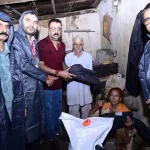Srinagar, July 21: In a first of its kind, a Kashmiri bird photographer has captured images of two rarely sighted birds in Kashmir wetlands, Red-necked Phalarope and sharp-tailed Sandpiper, which are rarely found in Kashmir.
This new discovery by bird photographer Reyan Sofi holds immense significance and has been published recently in Indian Birds, a prominent bi-monthly ornithology journal/newsletter.
In the Indian Subcontinent, the Red-necked Phalarope is common offshore along the coastline of Pakistan, less so in north-western India, and in small numbers and patchily, more or less off the entire coastline of peninsular India to Bangladesh and Sri Lanka.
On 16 August 2021, Reyan visited Hokersar Wetland in Srinagar which is a Ramsar site. The water level was so low in the wetland that small pools had formed.
“Near one such pool, I saw a wader, but couldn’t identify it. It was feeding hastily near the waters’ edge. I sent photographs to Intesar Suhail, who identified it as a red-necked Phalarope. It was moulting into its breeding plumage and had a dark grey head and upperparts, a rufous band on the side of its neck and breast, and a fine black bill, which separated it from the similar-looking red Phalarope,” he said.
Reyan said it was the first photograph that he captured with his new camera. The present record of the red-necked Phalarope from Hokersar, is the first for Jammu & Kashmir. However, it is not unexpected as the species has been recorded in adjacent regions on multiple occasions.
“In Gilgit-Baltistan the species is an uncommon migrant. There have been a few more records of the species from Ladakh (2022). The species is an uncommon but regular passage migrant in Himachal Pradesh, mainly at Pong Lake, and is seen on both, spring, and autumn passage,” he said.
Similarly, Reyan has also captured the image of sharp-tailed Sandpiper at the Hokersar Wetland which is a habitat for a large number of water birds.
“On 10 August 2021, he saw that the lake had shrunk hugely and water was present only in small pools. Near one such pool, I saw five birds and noticed an unfamiliar wader, which was larger than the stint but smaller than the Common Greenshank”, he said.
He clicked a few photographs and posted on the Facebook group ‘Ask IDS of Indian Birds’, where it was identified as a sharp-tailed Sandpiper.
“The bird had stayed there for a few days and was seen on many occasions by various birders. It was last seen on 23 August 2021,” Reyan said.
During the first two days the bird was seen feeding near the water along with five Common Greenshanks and was flying along with these birds. Later on, it was seen along with three Ruffs and on several occasions it was seen feeding alone.
“Although India is far westward of the Sharp-tailed Sandpiper’s migration route, vagrancy is not uncommon in this species. It is a rare vagrant to several European countries, as well as to South and South-east Asian countries to Kazakhstan, Middle East, Seychelles and Madagascar. It has also been reported from North America and even from South America and mainland Africa,” mentions the research journal.
He said the present record is significant as it is the first from the Union Territory of Jammu & Kashmir, and only the second confirmed record for the country.
Reyan thanked Sohail Iqbal and Rauf Zargar (DFO) for helping in every aspect of birding including providing vital information about the birds and birding areas, logistics, and for the encouragement.
Reyan the young birdman is not only capturing different species of local and migratory birds but also documenting them for the past seven years.
He said so far documented 300 species of different kinds of local and migrant birds in Kashmir only due to which he has become a popular name among bird lovers. Reyan is the member of birds of Kashmir Facebook Group where many birders post their beautiful pictures of birds.
First record of Red-necked Phalarope & sharp-tailed Sandpiper captured in Hokersar wetland
Leave a Comment Leave a Comment





